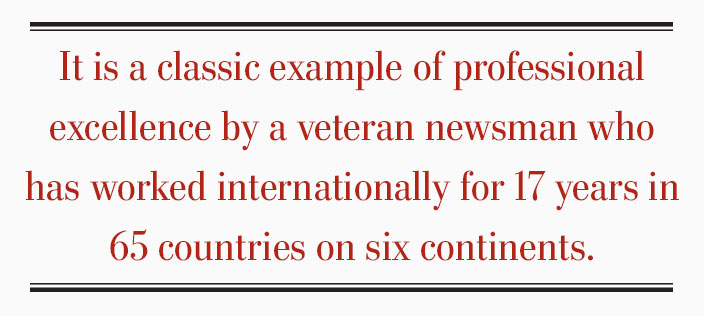
Two-year-old Jenela Sanchez of Honduras cries as her mother Sandra is searched and detained near the U.S.-Mexico border on June 12, 2018 in McAllen, Texas. [John Moore/Getty/World Press Photo Exhibition]
No wonder, then, that people want out. And where better, one would think, than to the United States of America, land of immigrants and home of dreams for countless refugees and displaced persons the world over?
Honduran toddler Yanela Sanchez and her mother Sandra were taken into custody by U.S. border officials in McAllen, Texas, on June 12, 2018, after President Donald Trump declared a state of emergency at the U.S.-Mexico border, where caravans of displaced persons were seeking refuge from violence, persecution, poverty and hunger.
Under the new “zero-tolerance” policy, migrants caught entering the U.S. illegally are being criminally prosecuted.
Photographer John Moore was there to capture the moment two-year-old Yanela burst into tears as her mother, shoelaces removed, was patted down by a uniformed officer, bathed in the headlights of border-patrol vehicles.

The photograph shows only the bottom half of the adults—mirroring the child’s perspective on the wrenching scene.
The picture—taken on assignment for Getty Images—won top prize in the 2019 World Press Photo competition, the pinnacle of photojournalistic honours. More than 150 images from the competition are on exhibition at the Canadian War Museum in Ottawa.
After the photograph was published worldwide, U.S. Customs and Border Protection confirmed that Yanela and her mother had not been among the thousands of displaced families separated and detained by American officials in 2017 and 2018. The family separation policy was officially abandoned shortly after.
But the child’s panicked wail—you can almost hear her as you gaze at the image—nevertheless came to represent the muffled cries of thousands more children who remain caged behind closed doors, out of public view and beyond the revealing light of news cameras. Officials have acknowledged that some detained children will likely not see their parents again.
Moore’s photograph was not a stroke of journalistic luck. It is a classic example of professional excellence by a veteran newsman who has worked internationally for 17 years in 65 countries on six continents.In an age when some believe that cellphone cameras and “citizen journalism” have changed the game and “democratized” the practice of news coverage, professionals like Moore, who produce compelling and enlightening work every day, remind us that the role and contributions of full-time paid news people may be more important than ever, even as their numbers diminish.
American newsroom employment has dropped by 25 per cent since 2008, with the greatest decline at newspapers, according to a Pew Research Center analysis of U.S. Bureau of Labor Statistics survey data.
In 2008, about 114,000 U.S. newsroom employees (reporters, editors, photographers and videographers) worked in five news-producing industries: newspaper, radio, broadcast television, cable and “other information services.” By 2018, that number had declined to about 86,000, a loss of about 28,000 jobs.
The hardest hit were newspapers, where the number of newsroom staff dropped 47 per cent between 2008 and 2018, from about 71,000 to 38,000.
The Canadian news industry is no better off. The Canadian Media Guild says 10,000 media jobs were lost in the past five years, 6,000 of them in print journalism.

Another photograph in the World Press Photo exhibit depicts Petronella Chigumbura, 30, an elite member of Zimbabwe’s all-female conservation ranger force known as Akashinga, as she undergoes sniper movement and concealment training in the bush near their base. [Brent Stirton/Getty/World Press Photo Exhibition]
“Moore has spent years working along the U.S.-Mexico border,” Alan Taylor wrote in an introduction to a portfolio of Moore’s work, “and regularly travels to Mexico and Central America, covering the many issues that surround the ongoing immigration crisis—its root causes in poverty, violence, and hopelessness; the dream of the United States as a better place for individuals and their children; the hazards of the immigrant’s journey; the pursuits and arrests at the border; the faces of those who choose to defend the border and of those who decide to risk everything to cross it.”
In an interview with National Public Radio in the United States, Moore recalled the making of the photograph, entitled Crying Girl on the Border.
It was a moonless night and the group, mostly families, had rafted across the Rio Grande from Mexico.
“I could see the fear on their faces, in their eyes,” said Moore. “As the border patrol took people’s names down, I could see a mother holding a young child.”

As agents began searching the detainees, the child burst into tears. “I took a knee and had very few frames of that moment before it was over.”
Moore spoke with them briefly in Spanish. Sandra Sanchez told him they had been on the road for a month trekking through Central America and Mexico. The mother then picked up her daughter. They boarded a van and were taken away.
Moore said he thinks about them often.
“As a photojournalist, it’s my role to keep going, even when it’s hard. But as a father—and I have a toddler myself—it was very difficult to see what was happening in front of my lens and thinking what it would be like for my kids to be separated from me.”Selections from this year’s competition, gleaned from 78,801 entries by 4,738 photographers from 129 countries, are on display in Ottawa through Aug. 11. Other Canadian stops include Montreal, Toronto and Chicoutimi, Que.
Advertisement
























